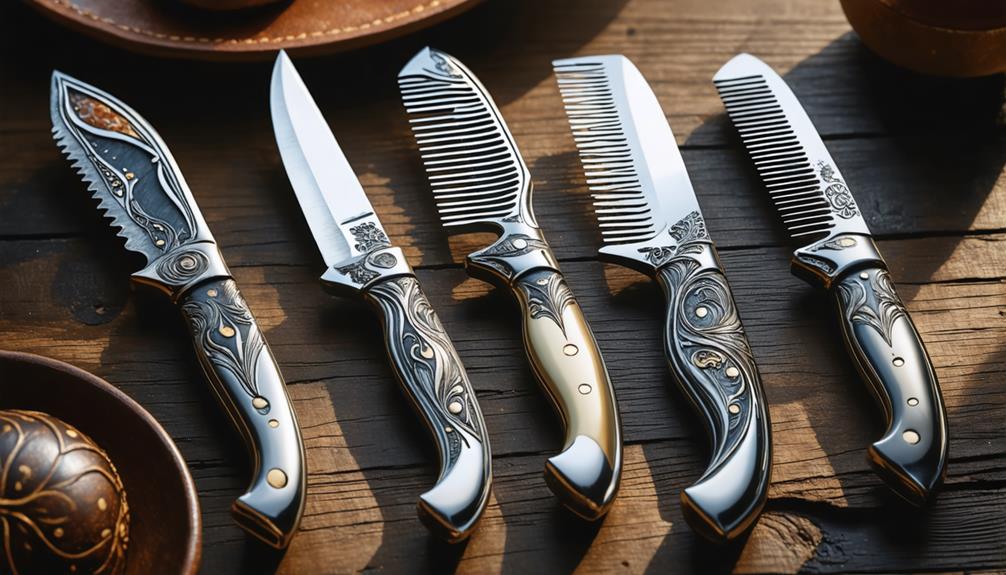
Brainstorm Security Shop

For Orders Over $199

On Any Of Our Products

Details On Refund Page

When you think about comb knives, you might picture a simple grooming tool, but there’s much more beneath the surface. These innovative implements combine the art of design with practical functionality, making them essential in various fields, from culinary arts to crafting. You’ll find that the choice of materials and craftsmanship greatly influences their performance. As you explore their history and diverse types, you may start to wonder how these tools have evolved over time and what practical applications they hold today. The answers might surprise you.
The history of comb knives is a fascinating journey through time, showcasing the evolution of a simple grooming tool into a multifunctional instrument. You mightn’t realize that these tools date back centuries, initially serving a dual purpose of grooming and cutting. Early versions were crafted from materials like bone or wood, symbolizing both utility and artistry in their design.
As you explore the timeline, you’ll see how comb knives evolved through various cultures, reflecting the changing needs and aesthetics of society. In ancient civilizations, they were often adorned with intricate carvings, representing status and skill. Over time, advancements in metallurgy and manufacturing techniques led to more refined and versatile designs.
You can appreciate how the comb knife’s evolution mirrors the progress of human craftsmanship and ingenuity. Each iteration not only improved functionality but also incorporated symbolic elements that spoke to the user’s identity and culture.
Today, these tools aren’t just practical; they hold a story of adaptation, representing the blend of utility and artistry that persists in modern grooming practices.
Variety defines the world of comb knives, offering you a range of options tailored to specific grooming and cutting needs. When exploring types of comb knives, you’ll notice the significance of blade shapes. Some knives feature straight edges perfect for precise trimming, while others boast curved blades that excel at shaping and contouring. Depending on your grooming style, the right blade shape can make all the difference.
Additionally, consider the folding mechanisms available in various models. Folding comb knives provide a compact option, easily fitting into your pocket or bag, making them ideal for on-the-go grooming. These knives often have secure locking mechanisms, ensuring safety during use.
On the other hand, fixed-blade comb knives offer durability and stability, catering to those who prefer a more robust tool.
Selecting the best type for your needs involves weighing the advantages of each blade shape and folding mechanism. By understanding these distinctions, you can choose a comb knife that enhances your grooming routine and meets your specific cutting requirements, ensuring you’re always prepared for the task at hand.
When it comes to comb knives, the choice of blade materials plays a crucial role in their performance and durability.
You’ll also find innovative handle designs that enhance comfort and grip, making them easier to use.
Plus, understanding the manufacturing techniques behind these tools can give you a deeper appreciation for their quality and craftsmanship.
In the world of comb knives, selecting the right blade material is crucial for achieving optimal performance and durability. You’ll encounter various steel choices that significantly impact your knife’s cutting ability and longevity. High-carbon steel, for instance, offers excellent sharpness and edge retention but requires regular maintenance to prevent rust.
On the other hand, stainless steel is more resistant to corrosion, making it a popular choice for those who prioritize low upkeep.
When you consider blade coatings, you’ll find that they can enhance your knife’s performance even further. Coatings like titanium or ceramic not only improve corrosion resistance but also reduce friction during cutting. This means smoother glides through materials, making your task easier and more efficient.
Additionally, some coatings can add aesthetic appeal, allowing you to customize your comb knife to reflect your personal style. Ultimately, understanding these factors will help you make an informed decision, ensuring you choose a blade material that meets your needs and enhances your experience. So, when you’re in the market for a comb knife, pay close attention to the steel choices and blade coatings available.
Innovative handle designs in comb knives are transforming user experience and functionality. You’ll notice that many modern handles prioritize comfort and usability, featuring ergonomic grips that conform to your hand shape. This thoughtful design reduces fatigue during extended use, allowing you to work more efficiently.
Materials play a crucial role in these innovations, with options ranging from lightweight plastics to durable woods. Choosing the right material not only enhances grip but also adds to the knife’s overall aesthetic. You might even find handles adorned with creative embellishments, such as unique textures or colors, making each knife a piece of art in its own right.
Additionally, many brands focus on balance and weight distribution in their handle designs. This careful consideration helps you maintain control while cutting or slicing, improving precision in every task. Whether you’re a professional chef or a home cook, these handle advancements can elevate your experience.
As you explore various comb knives, consider how these ergonomic grips and creative embellishments can enhance your culinary adventures. Investing in a well-designed handle can significantly impact your knife skills and overall enjoyment in the kitchen.
The craftsmanship behind comb knives involves a blend of advanced manufacturing techniques and quality materials that elevate their performance. When you examine a comb knife, you’ll notice that the design inspiration often draws from traditional knife-making, merging it with modern aesthetics. This results in a tool that’s not only functional but also visually appealing.
The production process typically starts with high-quality steel or durable composites, chosen for their ability to hold an edge while resisting corrosion. Skilled artisans then employ techniques like precision forging and CNC machining to shape the blade, ensuring consistent quality and performance.
During assembly, attention to detail is paramount; each component is meticulously fitted to guarantee optimal balance and control.
Finishing touches, such as polishing and coating, enhance both durability and appearance, giving the comb knife a sleek, professional look. Finally, rigorous quality checks ensure that every knife meets high standards before it reaches your hands. By understanding this manufacturing process, you can appreciate the level of expertise and care that goes into creating a comb knife, making it a worthy addition to your toolkit.
When you think about comb knives, their versatility shines through in both culinary and industrial settings. In the kitchen, you can use them for precise cutting and plating techniques, while in crafts and industry, they serve a variety of practical purposes. Let’s explore how these tools enhance your skills and efficiency in different applications.
Comb knives are versatile tools that can elevate your culinary skills. When you use a comb knife, you unlock numerous cutting techniques that enhance not just the efficiency of your prep work but also the safety of your kitchen tasks. By incorporating this tool into your routine, you can focus on creating beautiful, precise cuts without risking your fingers.
Culinary creativity flourishes when you experiment with different styles of presentation. A comb knife allows you to create intricate designs, making even the simplest dishes look gourmet. Whether you’re slicing vegetables for a salad or garnishing a plate, the comb knife helps you achieve uniformity and visual appeal.
To get the best results, practice your cutting techniques regularly. Start slowly to build confidence, ensuring each slice is controlled and clean. As you become more skilled, you’ll find that your culinary creativity knows no bounds.
The striking presentations you achieve with a comb knife will impress your guests and elevate your home cooking. So grab your comb knife, get creative, and watch as your culinary skills soar!
Harnessing the power of comb knives in industrial and craft applications can significantly enhance precision and efficiency. These versatile tools allow you to tackle a variety of projects with ease. Whether you’re working on detailed artistic customization or needing functional versatility in production settings, comb knives stand out.
Here’s a quick look at some practical uses:
| Application | Description |
|---|---|
| Woodworking | Ideal for creating intricate designs and textures. |
| Textile Industry | Perfect for cutting and shaping fabrics with precision. |
| Leather Crafting | Great for making patterns and detailed cuts in leather. |
| Food Preparation | Useful for intricate garnishing and presentation. |
Proper care and maintenance of your comb knives can significantly extend their lifespan and ensure optimal performance. Start by regularly cleaning your knives after each use. Use warm, soapy water and a soft cloth to wipe away any residue. Avoid abrasive materials that can scratch the surface. For stubborn spots, a gentle scrub with a non-abrasive sponge can do wonders. Always dry your knives thoroughly to prevent rust.
When it comes to storage solutions, consider using a dedicated knife block or magnetic strip to keep your comb knives organized and easily accessible. Make sure the storage method prevents the blades from coming into contact with other objects, as this can dull them.
If you’re storing them for an extended period, wrap the blades in a soft cloth to protect them from damage.
Lastly, periodically inspect your comb knives for any signs of wear or damage. Sharpen them as needed using a honing stone or professional sharpening service. By following these cleaning tips and storage solutions, you’ll ensure that your comb knives remain in top condition, ready to perform whenever you need them.
When it comes to choosing the right comb knives, several brands stand out for their quality and performance. Some brands offer collector’s items that not only serve as functional tools but also appreciate in value over time. Understanding which models to consider can enhance your collection and ensure you make a wise investment.
Here’s a quick comparison of popular comb knife brands and their standout features:
| Brand | Features |
|---|---|
| Case Knives | Unique designs, craftsmanship |
| Buck Knives | Customization options, durability |
| Gerber | Innovative designs, versatile usage |
| Schrade | Affordable, reliable performance |
| Spyderco | Ergonomic designs, collector’s items |
Each of these brands has its own unique offerings, making it easy for you to find a comb knife that fits your style and needs. Look for models that not only appeal to you aesthetically but also boast customization options that can set your knife apart. Remember, your choice can represent both a functional tool and a piece of art, which can appreciate in value over time.
The legality of carrying certain items varies by state, and you should always check local restrictions. While some may view them as practical tools, public perception can influence whether they’re accepted or prohibited in your area.
While comb knives might be stylish fashion accessories and seen in pop culture, using them for self-defense isn’t practical. Their primary purpose is aesthetic rather than functional in dangerous situations, so consider other options.
When you compare traditional pocket knives, you’ll notice that ergonomic design and discreet utility set some apart. While pocket knives provide versatility, others offer unique features that cater to specific needs without drawing attention.
The average cost of a comb knife typically ranges from $15 to $50, depending on the brand and features. Popular brands like Smith & Wesson and Kershaw offer reliable options within this price range.
Yes, comb knives can be considered collectibles. Their unique craftsmanship and rich history appeal to collectors. You’ll find various styles and designs that showcase the artistry and evolution of these fascinating tools throughout time.
Brainstorm Security Shop
1867 Caravan Trail
Ste 105
Jacksonville, FL 32216
Call us toll free: (800) 859-5566